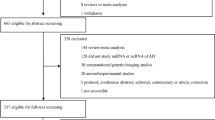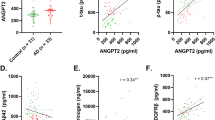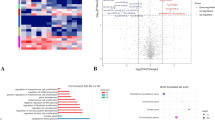Abstract
Transient receptor potential canonical 6 (TRPC6) inhibits β-amyloid (Aβ) production. Hyperforin, the TRPC6 agonist, reduces Aβ levels and improves cognitive performance in Alzheimer’s disease (AD) models. However, it’s unknown whether TRPC6 expression is changed in AD patients. In this case–control study, we measured TRPC6 expression levels in the peripheral blood cells of four independent AD sets from five hospitals and one mild cognitive impairment (MCI) set from a local community (229 AD, 70 MCI, 40 Parkinson disease and 359 controls from China, total n=698) using quantitative real-time PCR assay. We found a specific reduction of TRPC6 mRNA levels in four AD sets and one MCI set. The median TRPC6 mRNA levels were lower in the following: (1) combined AD patients than in age-matched controls (0.78 vs 1.73, P<0.001); (2) mild-to-moderate AD patients than in age-matched controls (0.81 vs 1.73, P<0.001); and (3) MCI patients than in age-matched controls (0.76 vs 1.72, P<0.001). In the receiver-operating characteristic curve analysis, the area under curve was 0.85 for combined AD, 0.84 for mild-to-moderate AD and 0.79 for MCI. In a subgroup of AD patients with brain Aβ examination, TRPC6 was associated with standardized uptake value ratio of Pittsburgh Compound B (Spearman’s r=−0.49, P=0.04) and cerebrospinal fluid Aβ42 (Spearman’s r=0.43, P=0.04). The TRPC6 reduction in AD patients was further confirmed in blood RNA samples from The Australian Imaging, Biomarkers and Lifestyle Flagship Study of Aging, in post-mortem brain tissues from The Netherlands Brain Bank and in induced pluripotent stem cells-derived neurons from Chinese donors. We conclude that TRPC6 mRNA levels in the blood cells are specifically reduced in AD and MCI patients, and TRPC6 might be a biomarker for the early diagnosis of AD.
This is a preview of subscription content, access via your institution
Access options
Subscribe to this journal
Receive 12 print issues and online access
$259.00 per year
only $21.58 per issue
Buy this article
- Purchase on Springer Link
- Instant access to full article PDF
Prices may be subject to local taxes which are calculated during checkout





Similar content being viewed by others
References
World Alzheimer Report 2010: The Global Economic Impact of Dementia. Alzheimer’s disease International, http://www.alz.co.uk/research/files/WorldAlzheimerReport2010.pdf.
Sevigny J, Chiao P, Bussiere T, Weinreb PH, Williams L, Maier M et al. The antibody aducanumab reduces Abeta plaques in Alzheimer’s disease. Nature 2016; 537: 50–56.
Jack CR Jr., Knopman DS, Jagust WJ, Shaw LM, Aisen PS, Weiner MW et al. Hypothetical model of dynamic biomarkers of the Alzheimer’s pathological cascade. Lancet Neurol 2010; 9: 119–128.
O'Bryant SE, Xiao G, Barber R, Reisch J, Doody R, Fairchild T et al. A serum protein-based algorithm for the detection of Alzheimer disease. Arch Neurol 2010; 67: 1077–1081.
Ray S, Britschgi M, Herbert C, Takeda-Uchimura Y, Boxer A, Blennow K et al. Classification and prediction of clinical Alzheimer’s diagnosis based on plasma signaling proteins. Nat Med 2007; 13: 1359–1362.
Mapstone M, Cheema AK, Fiandaca MS, Zhong X, Mhyre TR, MacArthur LH et al. Plasma phospholipids identify antecedent memory impairment in older adults. Nat Med 2014; 20: 415–418.
Kingsmore SF . Multiplexed protein measurement: technologies and applications of protein and antibody arrays. Nat Rev Drug Discov 2006; 5: 310–320.
Hye A, Lynham S, Thambisetty M, Causevic M, Campbell J, Byers HL et al. Proteome-based plasma biomarkers for Alzheimer's disease. Brain 2006; 129 (Pt 11): 3042–3050.
Moran MM, Xu H, Clapham DE . TRP ion channels in the nervous system. Curr Opin Neurobiol 2004; 14: 362–369.
Wang J, Lu R, Yang J, Li H, He Z, Jing N et al. TRPC6 specifically interacts with APP to inhibit its cleavage by gamma-secretase and reduce Abeta production. Nat Commun 2015; 6: 8876.
Leuner K, Kazanski V, Muller M, Essin K, Henke B, Gollasch M et al. Hyperforin—a key constituent of St. John's wort specifically activates TRPC6 channels. FASEB J 2007; 21: 4101–4111.
Montecinos-Oliva C, Schuller A, Parodi J, Melo F, Inestrosa NC . Effects of tetrahydrohyperforin in mouse hippocampal slices: neuroprotection, long-term potentiation and TRPC channels. Curr Med Chem 2014; 21: 3494–3506.
Leuner K, Li W, Amaral MD, Rudolph S, Calfa G, Schuwald AM et al. Hyperforin modulates dendritic spine morphology in hippocampal pyramidal neurons by activating Ca(2+) -permeable TRPC6 channels. Hippocampus 2013; 23: 40–52.
Muller M, Essin K, Hill K, Beschmann H, Rubant S, Schempp CM et al. Specific TRPC6 channel activation, a novel approach to stimulate keratinocyte differentiation. J Biol Chem 2008; 283: 33942–33954.
Gibon J, Deloulme JC, Chevallier T, Ladeveze E, Abrous DN, Bouron A . The antidepressant hyperforin increases the phosphorylation of CREB and the expression of TrkB in a tissue-specific manner. Int J Neuropsychopharmacol 2013; 16: 189–198.
Dinamarca MC, Cerpa W, Garrido J, Hancke JL, Inestrosa NC . Hyperforin prevents beta-amyloid neurotoxicity and spatial memory impairments by disaggregation of Alzheimer's amyloid-beta-deposits. Mol Psychiatry 2006; 11: 1032–1048.
Cerpa W, Hancke JL, Morazzoni P, Bombardelli E, Riva A, Marin PP et al. The hyperforin derivative IDN5706 occludes spatial memory impairments and neuropathological changes in a double transgenic Alzheimer's mouse model. Curr Alzheimer Res 2010; 7: 126–133.
Inestrosa NC, Tapia-Rojas C, Griffith TN, Carvajal FJ, Benito MJ, Rivera-Dictter A et al. Tetrahydrohyperforin prevents cognitive deficit, Abeta deposition, tau phosphorylation and synaptotoxicity in the APPswe/PSEN1DeltaE9 model of Alzheimer’s disease: a possible effect on APP processing. Transl Psychiatry 2011; 1: e20.
Mohr S, Liew CC . The peripheral-blood transcriptome: new insights into disease and risk assessment. Trends Mol Med 2007; 13: 422–432.
Kohane IS, Valtchinov VI . Quantifying the white blood cell transcriptome as an accessible window to the multiorgan transcriptome. Bioinformatics 2012; 28: 538–545.
Gladkevich A, Kauffman HF, Korf J . Lymphocytes as a neural probe: potential for studying psychiatric disorders. Prog Neuropsychopharmacol Biol Psychiatry 2004; 28: 559–576.
Folstein MF, Folstein SE, McHugh PR . “Mini-mental state”. A practical method for grading the cognitive state of patients for the clinician. J Psychiatr Res 1975; 12: 189–198.
McKhann G, Drachman D, Folstein M, Katzman R, Price D, Stadlan EM . Clinical diagnosis of Alzheimer’s disease: report of the NINCDS-ADRDA Work Group under the auspices of Department of Health and Human Services Task Force on Alzheimer’s Disease. Neurology 1984; 34: 939–944.
Hughes CP, Berg L, Danziger WL, Coben LA, Martin RL . A new clinical scale for the staging of dementia. Br J Psychiatry 1982; 140: 566–572.
Petersen RC, Smith GE, Waring SC, Ivnik RJ, Tangalos EG, Kokmen E . Mild cognitive impairment: clinical characterization and outcome. Arch Neurol 1999; 56: 303–308.
Jankovic J . Parkinson's disease: clinical features and diagnosis. J Neurol Neurosurg Psychiatry 2008; 79: 368–376.
Klunk WE, Engler H, Nordberg A, Wang Y, Blomqvist G, Holt DP et al. Imaging brain amyloid in Alzheimer’s disease with Pittsburgh Compound-B. Ann Neurol 2004; 55: 306–319.
Ellis KA, Bush AI, Darby D, De Fazio D, Foster J, Hudson P et al. The Australian Imaging, Biomarkers and Lifestyle (AIBL) study of aging: methodology and baseline characteristics of 1112 individuals recruited for a longitudinal study of Alzheimer’s disease. Int Psychogeriatr 2009; 21: 672–687.
Detre S, Saclani Jotti G, Dowsett M . A “quickscore” method for immunohistochemical semiquantitation: validation for oestrogen receptor in breast carcinomas. J Clin Pathol 1995; 48: 876–878.
Dowey SN, Huang X, Chou B-K, Ye Z, Cheng L . Generation of integration-free human induced pluripotent stem cells from postnatal blood mononuclear cells by plasmid vector expression. Nat Protoc 2012; 7: 2013–2021.
Chou B-K, Mali P, Huang X, Ye Z, Dowey SN, Resar LMS et al. Efficient human iPS cell derivation by a non-integrating plasmid from blood cells with unique epigenetic and gene expression signatures. Cell Res 2011; 21: 518–529.
Ivanovic Z, Su R-J, Baylink DJ, Neises A, Kiroyan JB, Meng X et al. Efficient generation of integration-free iPS cells from human adult peripheral blood using BCL-XL together with Yamanaka factors. PLoS ONE 2013; 8: e64496.
Schmittgen TD, Livak KJ . Analyzing real-time PCR data by the comparative C(T) method. Nat Protoc 2008; 3: 1101–1108.
Calciano MA, Zhou W, Snyder PJ, Einstein R . Drug treatment of Alzheimer’s disease patients leads to expression changes in peripheral blood cells. Alzheimers Dement 2010; 6: 386–393.
Robinson DM, Keating GM . Memantine: a review of its use in Alzheimer’s disease. Drugs 2006; 66: 1515–1534.
Scott LJ, Goa KL . Galantamine: a review of its use in Alzheimer’s disease. Drugs 2000; 60: 1095–1122.
Rogers SL, Doody RS, Mohs RC, Friedhoff LT . Donepezil improves cognition and global function in Alzheimer disease: a 15-week, double-blind, placebo-controlled study. Donepezil Study Group. Arch Intern Med 1998; 158: 1021–1031.
Lefevre G, Callegari F, Gsteiger S, Xiong Y . Effects of renal impairment on steady-state plasma concentrations of rivastigmine: a population pharmacokinetic analysis of capsule and patch formulations in patients with Alzheimer’s disease. Drugs Aging 2016; 33: 725–736.
Biber A, Fischer H, Romer A, Chatterjee SS . Oral bioavailability of hyperforin from hypericum extracts in rats and human volunteers. Pharmacopsychiatry 1998; 31 (Suppl 1): 36–43.
Sharp FR, Xu H, Lit L, Walker W, Apperson M, Gilbert DL et al. The future of genomic profiling of neurological diseases using blood. Arch Neurol 2006; 63: 1529–1536.
Scherzer CR, Eklund AC, Morse LJ, Liao Z, Locascio JJ, Fefer D et al. Molecular markers of early Parkinson’s disease based on gene expression in blood. Proc Natl Acad Sci USA 2007; 104: 955–960.
Padmos RC, Hillegers MH, Knijff EM, Vonk R, Bouvy A, Staal FJ et al. A discriminating messenger RNA signature for bipolar disorder formed by an aberrant expression of inflammatory genes in monocytes. Arch Gen Psychiatry 2008; 65: 395–407.
Zhou J, Du W, Zhou K, Tai Y, Yao H, Jia Y et al. Critical role of TRPC6 channels in the formation of excitatory synapses. Nat Neurosci 2008; 11: 741–743.
Griesi-Oliveira K, Acab A, Gupta AR, Sunaga DY, Chailangkarn T, Nicol X et al. Modeling non-syndromic autism and the impact of TRPC6 disruption in human neurons. Mol Psychiatry 2015; 20: 1350–1365.
Jia Y, Zhou J, Tai Y, Wang Y . TRPC channels promote cerebellar granule neuron survival. Nat Neurosci 2007; 10: 559–567.
Rowe CC, Ng S, Ackermann U, Gong SJ, Pike K, Savage G et al. Imaging beta-amyloid burden in aging and dementia. Neurology 2007; 68: 1718–1725.
Kemppainen NM, Aalto S, Wilson IA, Nagren K, Helin S, Bruck A et al. PET amyloid ligand [11C]PIB uptake is increased in mild cognitive impairment. Neurology 2007; 68: 1603–1606.
Braak H, Braak E . Neuropathological stageing of Alzheimer-related changes. Acta Neuropathol 1991; 82: 239–259.
Thal DR, Rub U, Orantes M, Braak H . Phases of A beta-deposition in the human brain and its relevance for the development of AD. Neurology 2002; 58: 1791–1800.
Griffith TN, Varela-Nallar L, Dinamarca MC, Inestrosa NC . Neurobiological effects of Hyperforin and its potential in Alzheimer’s disease therapy. Curr Med Chem 2010; 17: 391–406.
Mitchell AJ, Shiri-Feshki M . Rate of progression of mild cognitive impairment to dementia—meta-analysis of 41 robust inception cohort studies. Acta Psychiatr Scand 2009; 119: 252–265.
Jellinger KA, Attems J . Neuropathological evaluation of mixed dementia. J Neurol Sci 2007; 257: 80–87.
Schneider JA, Arvanitakis Z, Bang W, Bennett DA . Mixed brain pathologies account for most dementia cases in community-dwelling older persons. Neurology 2007; 69: 2197–2204.
Hardy J, Selkoe DJ . The amyloid hypothesis of Alzheimer’s disease: progress and problems on the road to therapeutics. Science 2002; 297: 353–356.
Wang Y, Ding M, Chaudhari S, Ding Y, Yuan J, Stankowska D et al. Nuclear factor kappaB mediates suppression of canonical transient receptor potential 6 expression by reactive oxygen species and protein kinase C in kidney cells. J Biol Chem 2013; 288: 12852–12865.
Graham S, Gorin Y, Abboud HE, Ding M, Lee DY, Shi H et al. Abundance of TRPC6 protein in glomerular mesangial cells is decreased by ROS and PKC in diabetes. Am J Physiol Cell Physiol 2011; 301: C304–315.
Fillit H, Ding WH, Buee L, Kalman J, Altstiel L, Lawlor B et al. Elevated circulating tumor necrosis factor levels in Alzheimer’s disease. Neurosci Lett 1991; 129: 318–320.
Perry G, Castellani RJ, Hirai K, Smith MA . Reactive oxygen species mediate cellular damage in Alzheimer disease. J Alzheimers Dis 1998; 1: 45–55.
Acknowledgements
This work was partially supported by the grants from the National Key Research and Development Program Foundation of China (2016YFC1306400), and from the Origincell Technology Group Co. Ltd, China. The funders had no role in study design, data collection and analysis, decision to publish or preparation of the manuscript. RL and JFW did the experiments and wrote the manuscript. YMS, HLL, YG, WZ, YJW, SDC, CJZ and ZYW made diagnosis of patients and collected clinical samples. JW, CJF, QXL and CLM did the experiments with the AIBL samples. RT and NHJ did establishment and induction of iPSCs. TZ repeated some experiments. RL and JFW analyzed the data. YZW supervised the project and wrote the manuscript. RL and YZW have full access to all of the data in the study and take responsibility for the integrity of the data and the accuracy of the data analysis.
Author information
Authors and Affiliations
Corresponding author
Ethics declarations
Competing interests
A Chinese patent application entitled ‘Methods for early diagnosis of Alzheimer’s disease by the measurement of TRPC6 mRNA levels in the peripheral blood cells’ (201410035943.8) was filed on 24 January 2014. RL, JW and YW are the inventors. The applicant is Shanghai Institutes for Biological Sciences, Chinese Academy of Sciences. A PCT patent application entitled ‘Methods for early diagnosis of Alzheimer’s disease by the measurement of TRPC6 mRNA levels in the peripheral blood cells’ (PCT/CN2014/071325) was filed on 24 January 2014. RL, JW and YW are the inventors. The applicant is Shanghai Institutes for Biological Sciences, Chinese Academy of Sciences. All other authors declare that there are no conflicts of interest.
Additional information
Supplementary Information accompanies the paper on the Molecular Psychiatry website
Supplementary information
Rights and permissions
About this article
Cite this article
Lu, R., Wang, J., Tao, R. et al. Reduced TRPC6 mRNA levels in the blood cells of patients with Alzheimer’s disease and mild cognitive impairment. Mol Psychiatry 23, 767–776 (2018). https://doi.org/10.1038/mp.2017.136
Received:
Revised:
Accepted:
Published:
Issue Date:
DOI: https://doi.org/10.1038/mp.2017.136
This article is cited by
-
A blood mRNA panel that differentiates Alzheimer’s disease from other dementia types
Journal of Neurology (2023)
-
Transient Receptor Potential Canonical 6 (TRPC6) Channel in the Pathogenesis of Diseases: A Jack of Many Trades
Inflammation (2023)
-
Identification of common core ion channel genes in epilepsy and Alzheimer’s disease
Irish Journal of Medical Science (1971 -) (2023)
-
Mutations in trpγ, the homologue of TRPC6 autism candidate gene, causes autism-like behavioral deficits in Drosophila
Molecular Psychiatry (2022)
-
Analysis of hyperforin (St. John’s wort) action at TRPC6 channel leads to the development of a new class of antidepressant drugs
Molecular Psychiatry (2022)



